The first US SPAAML: The MIM-72 Chaparral was a quite unique in the long list of M113 armored personal carrier's variants: This was the cmbination of the M48 utility/cabin flatbed variant, fitted with the MIM-72A sidewinder missile launchers. It was intended to give an organic AA defence to mounted infantry regiments, designed in 1965, produced from 1967 until 1981, in service at the end of the Vietnam war and retired in 1992 with circa 1,100 vehicles converted. The M48 Chaparral system was an US self propelled surface-to-air missile system MIM-72 based on the AIM-9 Sidewinder, mounted on the M113 derived M730.

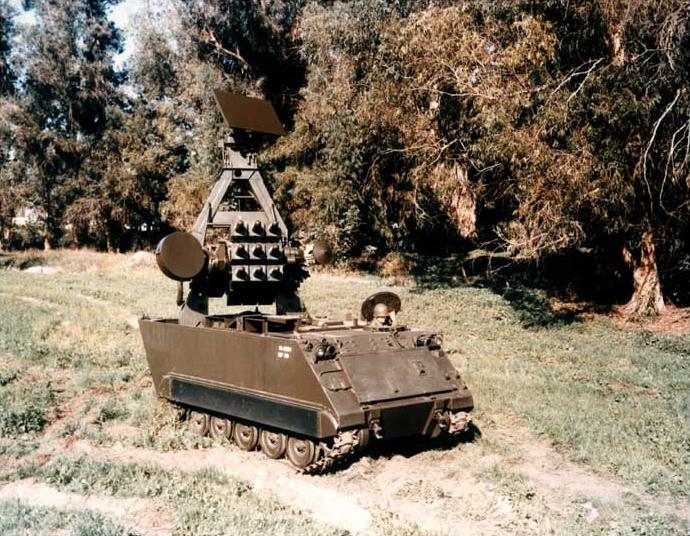
MIM-46 Mauler prototype trials.
The MIM-46 Mauler was an Army program to design autonomously a self-propelled anti-aicraft system adaptable on a modified M113 in the late 1950s. The modified vehicle was the XM546 vehicle and its troop compartment was open, supporting the mast of a twin-leg nine canister missile system topped by an acquisition radar, with a tracking radar on its side (tracking and illumination continuous wave radar, and the fire control system. It was designed to destroy low-flying high-performance tactical fighters and short-range ballistic missiles. Unfortunately it was also too ambitious and was eventually canceled in November 1965. Later the MIM-72 Chaparral and M163 Vulcan were chosen to replace it.
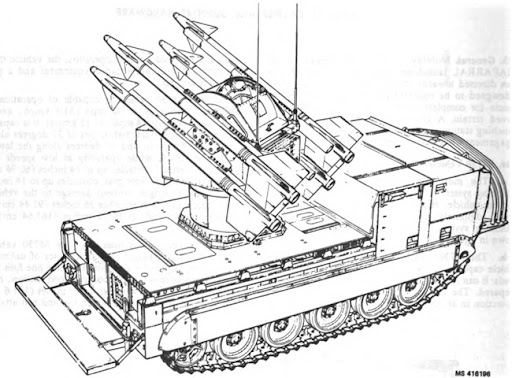
The M48 Chaparral was developed from 1965 as a less ambitious design using the proven AIM-9 Sidewinder, combined to the M548 tracked carrier. The flatbed features a one man turret supporting a swivel mount and two arms, each carrying a pair of missiles, so four infrared guided MIM-72 Chaparral surface to air missiles. The MIM-72 was the army derivative of the AIM-9 Sidewinder (see later) constantly improved until 1981. The five man crew was not inside the launcher vehicle but partly in the M730 launch vehicle and the others in the support vehicle. This was a pair M48/548 tracked carriers. The latter had eight spare missiles, to be reloaded by the remaining operators.
In 1966, development of the AN/MPQ-49 Forward Area Alerting Radar (FAAR) was approved to provide the Chaparral with target information. In 1967, the first XMIM-72A missiles were delivered to the U.S. Army. By May 1969 the first Chaparral battalion was sent in Vietnam.
The M48 Chaparral has four MIM-72 SAM (surface to air missiles) ready to fire, initially capable of covering a bubble 6 km in diameter and 3 km tall, later 9/6 km butr due to the tech of the tracling radar at the time, only a single missile could be launched at a time as the gunner needed to acquire a second target, mostly due to smoke dispersion. Only the later smokeless motor variant allowed to fire missiles quicker. Guidance was initially in clear weather, daulight only, as the gunner visually had to track the target, acquire an IR lock via the missile own seeker before launch. In the mid 1980's the system was provided a FLIR camera for the gunner, which when coupled with improved seekers allowed use at night and in adverse weather, like smoke and fog.
The base vehicle was a modified M730, based on the M548 tracked chassis caracterized by a simple COE (cab over engine) forward, and flatbed replacing the former hull. It was normally unarmoured, and offered a good all terrain mobility as well as commonality with the mass produced M113. The M48 was too heavy and lack buoyancy to be amphibious and the first models had a 9 t winch, later removed to spare weight. Technically a softskin vehicle it had has no radar system, so at least did not appeared by radar emission seeking missiles. The mount was capable of -9° to +90° elevation and 360° traverse, electrically powered by the engine, meaning the vehicle's thermic signature was obvious.
The drivetrain was the same as the M730 and M113, apart the engine was front-mounted in a different way, a General Motors 6V53T 6-cylinder turbo diesel rated for 275 hp at 2.800 rpm coupled with a an Allison X-200-4 tranmission with 4 forward, 2 reverse gearbox. It carried a fuel tank of 420 L. Performances wise, it was capable of 60 kph on flat, 410 km range, with a Power to weight ratio of 20.7 hp/t. It had a ground clearance of 0.43 m, coud climb 60 cm, gap a 1.7 m trench, 60% gradient, and ford 1 m of water, but again, it was not amphibious.
The gunner was located in the traversing mount, activating the angle of both arms, seated behind a plexiglas window, with a small door at the rear to accesss the mount. He had a dashboard with necessary intrumentation and a screen displaying the IE seeker data. The vehicle was upgraded just as the missile system: The M730 was similar to the M113A1 but the M730A1 had the improved engine and suspension of the M113A2 and the M730A2 RISE was like the M113A3 with an NBC system added and winch removed.
A close copy of the famous AIM-9 Sidewinder, first IR-guided short range missile in US inventory, widepread among NATO forces to this day (in some air forces).
Length 2.90 m; Diameter 127 mm (5 inches), Wingspan 0.63 m, Weight 86 kg.
Guidance used IR homing, Seeker type Nitrogen-cooled PbS. It had a 2.5° view, 12°/s tracking rate.
The Warhead located behind was a 11 kg MK 48 continuous rod type with a proximity fuse
It was powered by a MK 50 solid propellant rocket motor producing 12.2 kN for 4.7 s, up to Mach 1.5
Range was up to 6 km and altitude up to 3 km.
It was contunously improved. The 1980s MIM-72G had a Hercules M121 smokeless solid propellant rocket motor, for a 9 km range, alt. 4 km, AN/DAW-2 Rosette Scan Seeker, and a better M817 directional doppler fuse as well as a 12.6 kg M250 blast-fragmentation warhead. Unit cost was around 80k dollars, and a grand total of 21,000 of these arly missiles were manufactured, including 9500 of the early A/B variants.
28 units purchased in the 1980s, phased out as of 2024.
50 M-48 Chaparral as for 2024
Perhaps 50 delivered, shot down a Syrian MiG-17 over the Golan heights in May 1974, discarded 2003.
37 M-48 Chaparral as for 2024.
The Portuguese operated the M730/M48A3 Chaparral, 34 self-propelled surface-to-air missile systems, and in 2024 less than 25 vehicles. In service with the Portuguese Army since 1990. Portugal initially received 30 M730 in the A2 variant and afterwards 4 vehicles in the A3 variant. Removed from service 2018.
Republic of China Marine Corps had some based on modified local M113 Chassis, still active.

The Chaparral was ready for the final stage of the Vietnam war, but was apparently not deployed. It was provided by platoons of four at reguiment level in the US Army's tank divisions, together with the M163 Vulcan SPAAG which formed a two-layer bubble above the formation, 6 km wide. The latter was mostly dedicated to low-flying helicopter more difficult to spot by the Chaparral.
The crew in the forward cabin was unprotected from the elements, albeit a framed tarpaulin could be mounted and the windhield raised over the cabin, and extended to the rear of the vehicule to protect the whole missile launcher when not in use.
The vehicle was fielded to the US Army until after the end of the cold war in 1997. It took part in the Gulf war. Note that the MIM-72 Chaparral was also mounted on a twin-axle trailer as well, provided in large quantities, which could be towed by a regular M35 truck. The latter carried the reloads and extra personel.

Development
The XM548E1 was a variant of the XM548/M548 – Unarmored 6 ton cargo carrier, converted her as a launcher for the MIM-72 Chaparral SAM, M54 system, Redesignated XM730. The XM730/M730 – Unarmored carrier/launcher for the MIM-72 Chaparral surface-to-air missiles of the M54 system. The XM730 was formerly the XM548E1. The complete system is known as the M48. The MIM-72 Chaparral was a ground-launched derivative, wich development started in 1963 at the U.S. Army MICOM (Missile Command). In 1965, studies showed the conversion was feasible, and the Chaparral program was started after the cancelled MIM-46 Mauler.
MIM-46 Mauler prototype trials.
The MIM-46 Mauler was an Army program to design autonomously a self-propelled anti-aicraft system adaptable on a modified M113 in the late 1950s. The modified vehicle was the XM546 vehicle and its troop compartment was open, supporting the mast of a twin-leg nine canister missile system topped by an acquisition radar, with a tracking radar on its side (tracking and illumination continuous wave radar, and the fire control system. It was designed to destroy low-flying high-performance tactical fighters and short-range ballistic missiles. Unfortunately it was also too ambitious and was eventually canceled in November 1965. Later the MIM-72 Chaparral and M163 Vulcan were chosen to replace it.

The M48 Chaparral was developed from 1965 as a less ambitious design using the proven AIM-9 Sidewinder, combined to the M548 tracked carrier. The flatbed features a one man turret supporting a swivel mount and two arms, each carrying a pair of missiles, so four infrared guided MIM-72 Chaparral surface to air missiles. The MIM-72 was the army derivative of the AIM-9 Sidewinder (see later) constantly improved until 1981. The five man crew was not inside the launcher vehicle but partly in the M730 launch vehicle and the others in the support vehicle. This was a pair M48/548 tracked carriers. The latter had eight spare missiles, to be reloaded by the remaining operators.
In 1966, development of the AN/MPQ-49 Forward Area Alerting Radar (FAAR) was approved to provide the Chaparral with target information. In 1967, the first XMIM-72A missiles were delivered to the U.S. Army. By May 1969 the first Chaparral battalion was sent in Vietnam.
Design of the M48 Chaparral

The M48 Chaparral has four MIM-72 SAM (surface to air missiles) ready to fire, initially capable of covering a bubble 6 km in diameter and 3 km tall, later 9/6 km butr due to the tech of the tracling radar at the time, only a single missile could be launched at a time as the gunner needed to acquire a second target, mostly due to smoke dispersion. Only the later smokeless motor variant allowed to fire missiles quicker. Guidance was initially in clear weather, daulight only, as the gunner visually had to track the target, acquire an IR lock via the missile own seeker before launch. In the mid 1980's the system was provided a FLIR camera for the gunner, which when coupled with improved seekers allowed use at night and in adverse weather, like smoke and fog.
The base vehicle was a modified M730, based on the M548 tracked chassis caracterized by a simple COE (cab over engine) forward, and flatbed replacing the former hull. It was normally unarmoured, and offered a good all terrain mobility as well as commonality with the mass produced M113. The M48 was too heavy and lack buoyancy to be amphibious and the first models had a 9 t winch, later removed to spare weight. Technically a softskin vehicle it had has no radar system, so at least did not appeared by radar emission seeking missiles. The mount was capable of -9° to +90° elevation and 360° traverse, electrically powered by the engine, meaning the vehicle's thermic signature was obvious.
The drivetrain was the same as the M730 and M113, apart the engine was front-mounted in a different way, a General Motors 6V53T 6-cylinder turbo diesel rated for 275 hp at 2.800 rpm coupled with a an Allison X-200-4 tranmission with 4 forward, 2 reverse gearbox. It carried a fuel tank of 420 L. Performances wise, it was capable of 60 kph on flat, 410 km range, with a Power to weight ratio of 20.7 hp/t. It had a ground clearance of 0.43 m, coud climb 60 cm, gap a 1.7 m trench, 60% gradient, and ford 1 m of water, but again, it was not amphibious.
The gunner was located in the traversing mount, activating the angle of both arms, seated behind a plexiglas window, with a small door at the rear to accesss the mount. He had a dashboard with necessary intrumentation and a screen displaying the IE seeker data. The vehicle was upgraded just as the missile system: The M730 was similar to the M113A1 but the M730A1 had the improved engine and suspension of the M113A2 and the M730A2 RISE was like the M113A3 with an NBC system added and winch removed.
The missile: MIM-72 (1969)

A close copy of the famous AIM-9 Sidewinder, first IR-guided short range missile in US inventory, widepread among NATO forces to this day (in some air forces).
Length 2.90 m; Diameter 127 mm (5 inches), Wingspan 0.63 m, Weight 86 kg.
Guidance used IR homing, Seeker type Nitrogen-cooled PbS. It had a 2.5° view, 12°/s tracking rate.
The Warhead located behind was a 11 kg MK 48 continuous rod type with a proximity fuse
It was powered by a MK 50 solid propellant rocket motor producing 12.2 kN for 4.7 s, up to Mach 1.5
Range was up to 6 km and altitude up to 3 km.
It was contunously improved. The 1980s MIM-72G had a Hercules M121 smokeless solid propellant rocket motor, for a 9 km range, alt. 4 km, AN/DAW-2 Rosette Scan Seeker, and a better M817 directional doppler fuse as well as a 12.6 kg M250 blast-fragmentation warhead. Unit cost was around 80k dollars, and a grand total of 21,000 of these arly missiles were manufactured, including 9500 of the early A/B variants.
Variants:
MIM-72A
Original production version as introduced in 1969. Based on AIM-9D Sidewinder. The MIM-72B is a training model of the MIM-72A.MIM-72C Improved Chaparral
Much improved version of the Chaparral. Uses all-aspect IR seeker, doppler radar fuse and new warhead. Introduced in 1974 and operational by 1978.MIM-72E/F
Variant of the MIM-72C with smokeless rocket motor. The reduced fire signature doesn't impede visibility for a follow-up shot, and reduces the enemy's ability to determine the launch site. MIM-72F indicates a new built missile and the MIM-72E is a retrofitted MIM-72C.MIM-72G
Upgrade of existing Chaparral missiles with AN/DAW-2 seeker as used on the FIM-92 Stinger. Upgrade applied in the late 1980's . Also produced as a new missile once upgrade program was complete.MIM-72H
Export model of the MIM-72F.MIM-72J
Downgraded export model of MIM-72G.RIM-72/72C sea Chaparral
The RIM-72C is used on the Sea Chaparral, practically similar to the MIM-72C as one man naval mount for the Chaparral missile. It entered service in the Mid 1970s after being developed from 1972 to 1973 by Lockheed Martin, with about 20 launchers and 250 missiles made for naval use. There was a manual control by operator for fire control, and an early warning provided by the ship's radar system. It was tested but never really adopted by the USN, which designated them RIM-72. It was exported to Taiwan, Kang Ding class frigates.Exports:
 Chile
Chile
28 units purchased in the 1980s, phased out as of 2024.
 Egypt
Egypt
50 M-48 Chaparral as for 2024
 Israel
Israel
Perhaps 50 delivered, shot down a Syrian MiG-17 over the Golan heights in May 1974, discarded 2003.
 Morocco
Morocco
37 M-48 Chaparral as for 2024.
 Portugal
Portugal
The Portuguese operated the M730/M48A3 Chaparral, 34 self-propelled surface-to-air missile systems, and in 2024 less than 25 vehicles. In service with the Portuguese Army since 1990. Portugal initially received 30 M730 in the A2 variant and afterwards 4 vehicles in the A3 variant. Removed from service 2018.
 Taiwan
Taiwan
Republic of China Marine Corps had some based on modified local M113 Chassis, still active.
Action:

The Chaparral was ready for the final stage of the Vietnam war, but was apparently not deployed. It was provided by platoons of four at reguiment level in the US Army's tank divisions, together with the M163 Vulcan SPAAG which formed a two-layer bubble above the formation, 6 km wide. The latter was mostly dedicated to low-flying helicopter more difficult to spot by the Chaparral.
The crew in the forward cabin was unprotected from the elements, albeit a framed tarpaulin could be mounted and the windhield raised over the cabin, and extended to the rear of the vehicule to protect the whole missile launcher when not in use.
The vehicle was fielded to the US Army until after the end of the cold war in 1997. It took part in the Gulf war. Note that the MIM-72 Chaparral was also mounted on a twin-axle trailer as well, provided in large quantities, which could be towed by a regular M35 truck. The latter carried the reloads and extra personel.
M48 specifications | |
| Dimensions | 6.09 x 2.68 x 2.89 m |
| Total weight | 13.30 t |
| Crew | 2: driver/commander, gunner (3 more M730 supply carrier) |
| Propulsion | General Motors 6V53T turbodiesel 275 hp/2800 rpm, 20.7 hp/t |
| Transmission | Allison X-200-4, 4 forward, 2 reverse GBx |
| Suspension | Torsion bar, as M113 |
| Speed (road) | 56 km/h |
| Range | 420L tank, 410-483 km |
| Armament | M54 quad missile launcher, 4x MIM-72 missiles |
| sensor | IFF interrogator, thermal gunner optic |
| Armor | None |
| Total production | Unknown, c1100 |
Illustrations
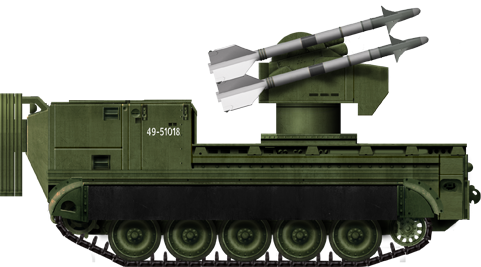
Basic US Army weapon system, 1970
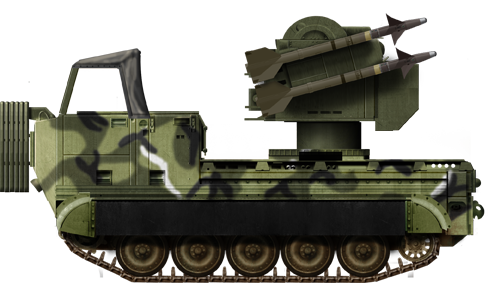
US Army vehicle with MERDC pattern and canvas 1985
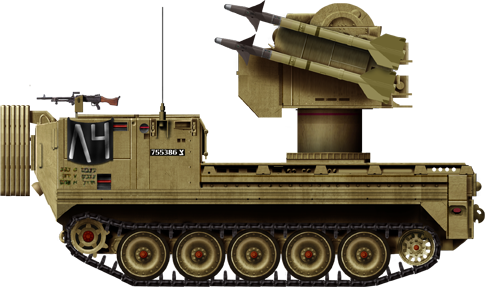
IDF vehicle, 1973
Photos
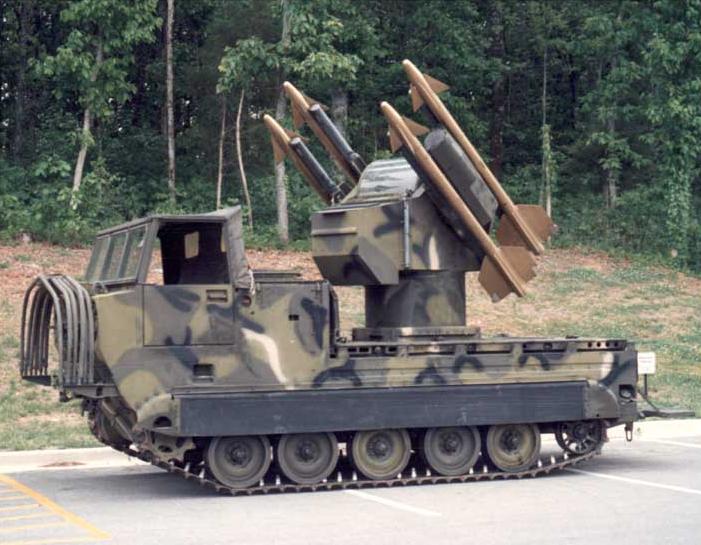





gulf war
More
apps.dtic.mil chaparral development pdfsidewinder on PE
weaponsystems.net/
history.redstone.army.mil
viaturasmilitaresportuguesas.blogspot.com
designation-systems.net
en.wikipedia.org
Variants_of_the_M113_armored_personnel_carrier
Video
MIM-72A CHAPARRAL SURFACE-TO-AIR MISSILE AND M163 VULCAN MINI GUN SYSTEM HISTORIC FILM
Cold War Tanks


































Cold war tanks posters

Cold War Main Battle Tanks

Cold War Soviet Army
Museums, Movies, Books & Games
The Tanks and Armor in pop culture
Tanks and armored vehicles in general are only really grasped when seen first person: The mass, the scale, it's all there. Explore also the way tanks were covered in the movie industry, in books and in video games.Movies:
Best tanks movie on warhistoryonline.com
On imdb.com
On bestsimilar.com/
miltours.com
liveabout.com/
watchmojo.com
Video Games:
pcgamesn.com
historyhit.com
levvvel.com
vg247.com/best-tank-games
mmobomb.com/
alienwarearena.com


